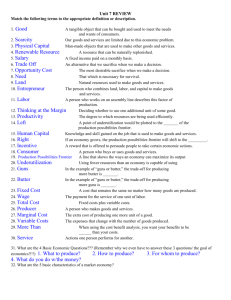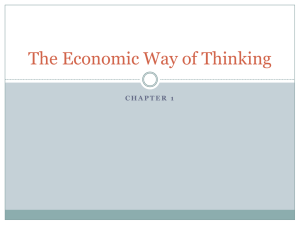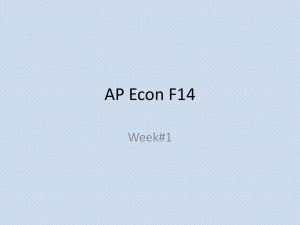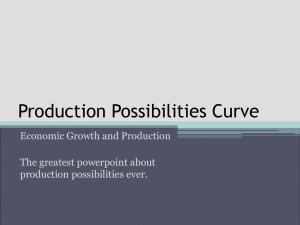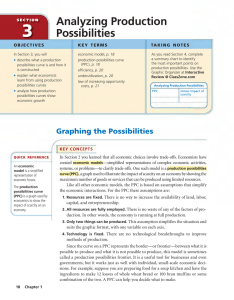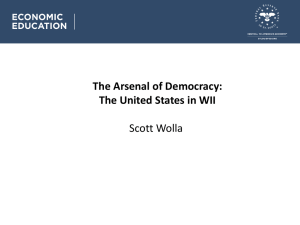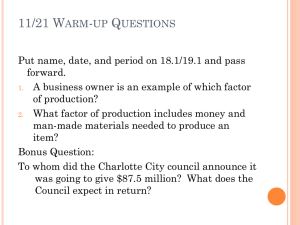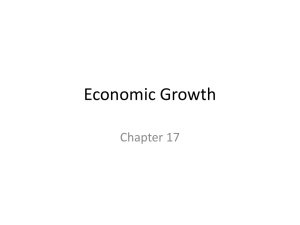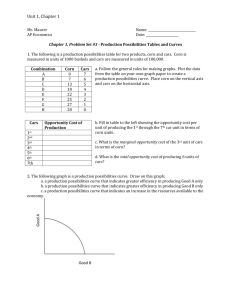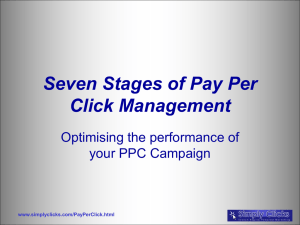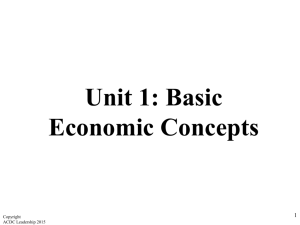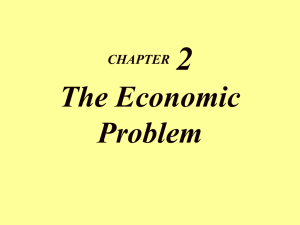Chapter 1, Section 3-Economics
advertisement
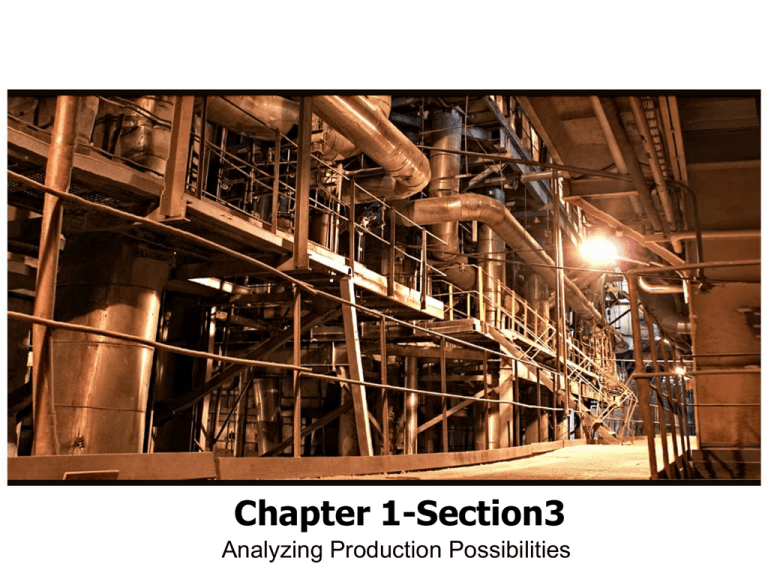
Chapter 1-Section3 Analyzing Production Possibilities Section 3 Objectives, pp. 18-23 • describe what a production possibilities curve is and how it is constructed • explain what economists learn from using production possibilities curves • analyze how production possibilities curves show economic growth Connecting to Everyday Life • What are your extracurricular activities and describe a typical week in your life. Now consider what would occur if all days were like your busiest. Would you be able to add more activities that interest you? Also, consider soon or later you would reach a point where there would be no more time for additional activities. Remember that businesses and economies, just like people, can reach a limit on what they can produce. Graphing the Possibilities • Economic models: economists have developed models to simplify the complex economic activities or problems. • Production Possibilities Curve (PPC): a graph that illustrates the scarcity by showing maximum number of goods and services that can be produced using limited resources. PPC • PPC Assumptions: • 1. Resources are fixed: No way to increase the availability of land, labor, capital, and entrepreneurship. • 2. All resources are fully employed: No waste of any of the factors of production. The economy is running at full production. PPC • 3. Only two things can be produced: Assumption simplifies the situation and suits the graphic format, with one variable on each axis. • 4. Technology is fixed: No technological breakthroughs to improve methods of production. Production Possibilities Curve • Figure 1.3: Production possibilities table on page 19 shows five production possibilities for loaves of bread and bran muffins. • Figure 1.4: The data is plotted on a graph. The line joining the plotted points is the production possibilities curve. The graph shows the maximum number of loaves of bread that can be produced in comparison to bran muffins that can be produced. Creating a PPC • Task: Create a PPC • Materials Needed: paper and pens or pencils Activity: a. You will be divided into groups. b. Each group is a small country and can make only two products and each group must decide what to make and how many of each. Resources are fixed, technology is fixed, and all resources are fully utilized. Your group can be creative in you choice of products. (must be Clean!) c. Each group will create a PPC for their two products. Your group can make up the numbers but that the PPC has to have the characteristic slope, so you will need to manipulate the numbers, look at the model in Figure 1.4 on page 19 as a guide. d. Each group will present and explain your PPC. What We Learn from PPCs • Efficiency: One idea in a PPC is the condition in which economic resources are being used to produce the maximum amount of goods and services. • Underutilization: This is a condition in which economic resources are not being used to full potential. • The outcome is fewer goods and services are being produced that the economy is capable of making. • Efficiency and Underutilization: Refer to figure 1.5: classic production possibilities model of gun versus butter. In the model guns represent military spending and butter represents consumer products. • Shape of the PPC: law of increasing opportunity costs-production switches from one product to another, more resources are needed to increase the production of the second product, this causes opportunity costs to rise. Increasing Opportunity Costs • • • • Refer again to figure 1.5: A. Point 1 curve: makes 250 million pounds of butter. B. Point 2 curve: wants to make 280 million pounds C. Opportunity cost of making the extra 30 million pounds of butter is 37 million guns. This costs about 1.2 guns for every pound of butter. • D. Point 5 curve: A nation might increase its output of butter to 312 million pounds. • E. Opportunity cost of the change would be 63 million guns—2 guns for every pound of butter. • F. Bow-shaped: is the reflection in the increase of the opportunity costadditional unit costs more to make. • The outcome for rising costs is pretty straightforward. Making butter involves different resources than making guns. You would have to convert from gun production to butter production is a difficult task. New machinery would have to be produced, factories would have to be built, and workers would need to be retrained. • Cost would be fewer and fewer guns. • Example: Guns vs. Butter in North Korea---Following WWII, North Korea came under communist control. The North Korean government made a decision to reallocate resources to strengthen its military, literally choosing guns over butter. By the late 1990s, millions of Koreans were dying of hunger because so many resources had been taken away from the production of necessities, such as food. Changing Production Possibilities • A Shift in the PPC: • What might cause production possibilities to change? Additional resources could make it possible to attain new production possibilities beyond the original frontier. Resources of a country are likely to change over time. • What developments caused the PPC for the United States to shift outward? Additional land brought an abundance of natural resources, immigration added huge numbers of workers, and new technology made land, labor, and capital more efficient.
